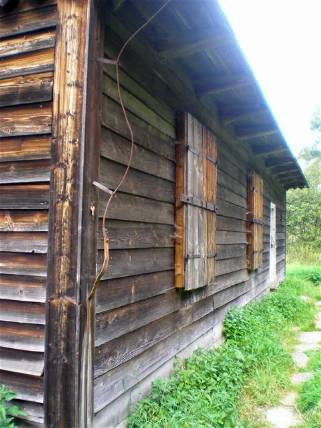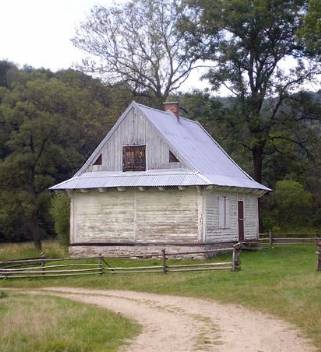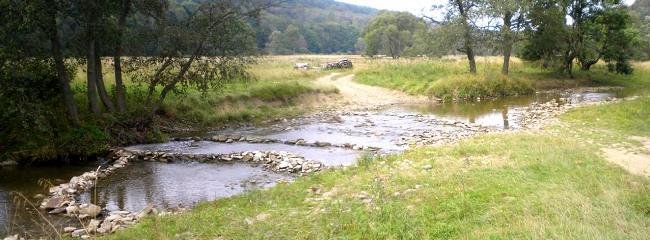The Search for Sadie
Nasze Chatka
"History in Nieznajowa
just doesn't hide on
some dusty shelf. It is in our midst. You can accidentally step on her
bunion. If you stop for a moment some distance from Rostajne and close your eyes, you may
surprisingly find yourself among blue painted houses, smell the scent of growing
wheat, hear creaking of wooden wheels from hay wagons, and meet people who
used to live here over 60 years ago.
In 1936, Nieznajowa had 250 souls living there.
It was a large, pulsating with life Lemko village. Children used to go to school
with a Polish teacher, housewives gossiped beside the one of
the two stores. There even was a pub, a vestige of Austrian times, where one could
drown the sadness of everyday life. If somebody caused a problem in the pub, the
police station was right there to ensure that everything was under
control.
Markets took place every two weeks in Nieznajowa. This made Nieznajowa
well known in the whole area. Traders came
from Zmigrod and Gorlice. Even larger markets took place four times each
year.
There were two sawmills in the village.
One was equipped with a steam engine, mill wheels, and an electrical
power generator. It stood near the road to Rostajne. The other sawmill was the water
mill near the Wisloka River and above the Zawoja River. It was run by the
local postmaster. The larger sawmill
was closed down for some possible renovations and the second one was detonated by
Germans at the end of the war.
Near the Zawoja River, there used to be a
small Orthodox church, one of the most beautiful in Beskid Niski. Nearby, only
stone graves mark the resting place of last village
inhabitants.

In 1945, it all ended. In the name of
the "freedom of movement"
of Ukrainian, Byelorussian, Russian, Rusyn citizens, all Lemkos from Nieznajowa
departed to Soviet Union. The village stood empty.
What can we see today ? Not one house
is left there. In the grass, one can see forgotten road chapels. The
remainder of the Orthodox church fell apart in 70's. Cemetery crosses
are overgrown by grass. There are the ruins of the old
sawmill on the road to Rostajne. We can still find the location of the
old pub, where people were able to drink and dance. Where the old market stood,
now only high grass is growing. Now, if we close our eyes for moment
again...
A different story is told about Our Cabin
("Nasza Chatka"). Before war, this cabin was a forester's
house. The sign above the door read: "Lasy Zagorzany, Lesnictwo Nieznajowa"
(Forests Zagorzany, Forestry Nieznajowa). The forester lived in part of this
house. Behind its walls, in a second part, a ranger with his family used to
live. Electricity was drawn from sawmill. Possibly also the post office was
located at this place. After school, children from school often came to the forester to
listen to his radio. In 1944, German military staff took over the house. The
ranger and his family moved to farm buildings. The forester died in the
war in 1939 while the ranger was
transported by the UPA in Spring 1947 to some unknown place. After the war, for a short time, forester's
house had returned to its original function.

Another populated building was a wooden cabin
moved here from a hilltop near Lipna. Some Pole made a private
shelter inside of it. In 1969, the forester's house became a penal
institution. Its prisoners were sure that they had been taken deep into
Siberia. Its existence ended during the state of emergency in Poland in
1981.
The legend says that one can still hear
ghostly odd sounds in Nasze Chatka while nobody is there. Maybe it is that
forester, maybe some escaping and killed prisoner.... There is no actual
information about this.
Not too long ago, there were still holes in the wall
from bullets. Maybe this is a ghost of this unlucky escaping person
visiting with us after the sun is down.
Did you hear about Earl Bogus? The story
tells that this odd man lived in Nieznajowa. Where the kitchen is now, a
large bed with baldachin used to stand. A small liquor cabinet, made
in a wooden stump and full of different drinks, stood in the corner. Earl had guests often and many
grill parties took place here. The story says that Earl on his white horse
travelled in the area and sullied all of the village girls around here. Another version
says that Earl was in love but this wasn't a lucky alliance. When he
discovered that his lady found somebody else, he shot himself. Many people would
now say that this is a ghost of Earl Bogus scaring people at night in Nasze Chatka.
Others say that this isn't true, because Earl shot himself in Golesze near Jaslo and died at the hospital
there.
One place, so much can be said. If this house could speak, it would tell many
stories..."

By Monika Sikorska
Member of Volunteer Chatka Group for Nieznajowa
Translated with permission by Grace Skowron

Karen Wisniewski, Detroit USA 2008
Photos by Robert Zasadni, 2008
Background music: Fale Dunaju
Layout and stuff by Dionizy Bieniasz
